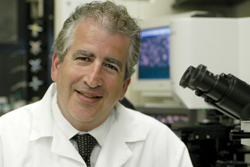Rappaport embodies the best as a researcher and mentor
Faculty Research Award
 Photo by Temple University Photography
Rappaport
|
Where most 8-year-old boys aspire to grow up to be cowboys, astronauts or firemen, Jay Rappaport, professor and vice chair of neuroscience in the School of Medicine, had his career path solidly outlined by that point in his life.
“My hobby is chemistry and biology,” he wrote as a second grader at Philadelphia’s Gompers Elementary School. “When I grow up, I hope to be a scientist.” Forty-plus years later, Rappaport is not only a scientist, he is an internationally recognized researcher in the molecular pathogenesis of HIV infection in the central nervous system and the co-recipient of the 2009 Temple University Faculty Research Award. |
|
|
|
|
“I kind of knew early on,” he said about his early career prognostication. “As a young boy I was always interested in how things worked, and my parents were very supportive and encouraging.” His career really began in the early 1980s as a graduate student at the Wistar Institute, where he worked on uncovering the factors that controlled gene transcription in mammalian cells. After receiving his Ph.D. in 1986, Rappaport was recruited as a staff fellow to the National Institutes of Health, working in a lab that was focused in areas in molecular virology. But within six months, the head of the lab died from lymphoma. “When that happened, I thought about what I really wanted to do,” said Rappaport. “This was 1987. Human Immunodeficiency Virus (HIV), the cause of AIDS, had recently been discovered. A lot of work needed to be done on it, so I decided to work on HIV.” He moved to the NIH lab of HIV co-discoverer Robert Gallo and has been “working on HIV ever since.” From NIH, Rappaport moved to the University of California-San Diego, back to the NIH, and then to Mount Sinai School of Medicine. In 1997, neuroscience chair Kamel Khalili recruited him to the Center of NeuroVirology and NeuroOncology at MCP Hahnemann University, and he moved with the center to Temple’s College of Science and Technology in 1999. “I’ve been very fortunate at Temple to have a supportive research environment,” he said. “I have been really fortunate to have the support of our center director and, neuroscience department chair Kamel Khalili, biology department chair Shohreh Amini and School of Medicine Dean Daly.” Reflecting back on his achievements, Rappaport said, he is most proud of his recent work at Temple, which has been to identify and characterize the reservoirs of HIV in the brain and to demonstrate that the major cellular reservoirs of the virus were actually entering the brain from the blood stream. These cells in blood may actually turn out to be a target for therapy. “When real discoveries are made in an academic setting, it’s not just the work I do, it is putting your experience, and maybe your instincts, together with some really bright, talented and highly motivated students and staff,” he said. “If you want to be successful in research, you also have to be a good mentor. You have to be able to inspire and stimulate students to become intellectually invested in the research; and you also have to be lucky enough to be able to attract bright and talented individuals to work with you.” One such student is Tracy Fischer-Smith, who came to work with Rappaport as a graduate student. She had her sites set on going to veterinary school at the time, but under his mentorship became a collaborator and is now an assistant professor of neuroscience in the School of Medicine. “That’s another thing that I’m very proud of, to have been able to mentor people like Tracy, and that they have been able to become successful in their own careers.” |
|